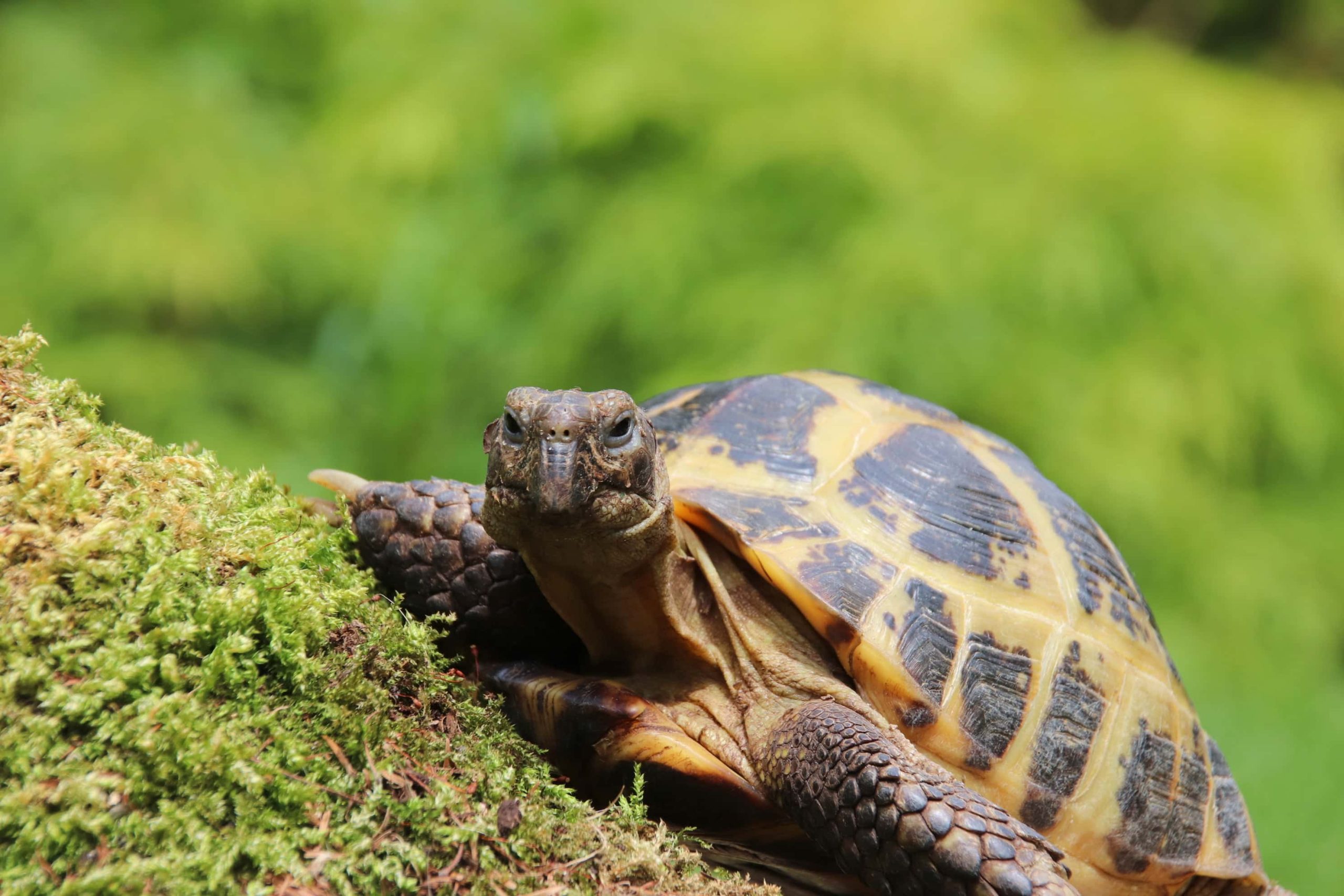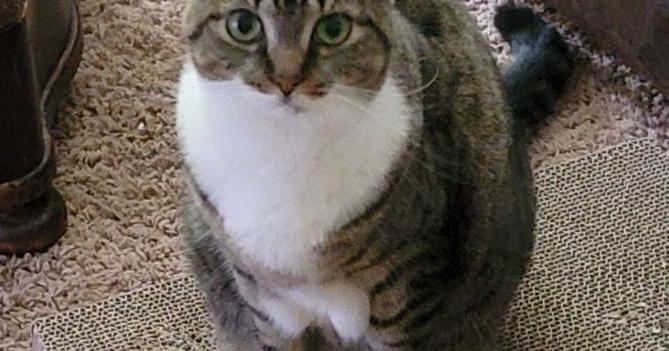The Russian Tortoise is one of the most popular pet tortoises around, and when you spend time with one, it’s easy to understand why. They are quite active and friendly and are great pets for first-time tortoise owners.
If you’ve been thinking about adding a tortoise to your life, you can’t go wrong with the Russian Tortoise. Here’s all the information that you need to help you decide if you want to bring this tortoise into your life.
Breed Overview
| Size: | 6–10 inches |
| Weight: | ½–2½ pounds |
| Lifespan: | Up to 50 years |
| Suitable for: | Beginner and experienced tortoise owners |
| Temperament: | Friendly, active, social, personable |
The Russian Tortoise does originate in Russia but is also found in Afghanistan, China, Iran, and Pakistan in dry, open spaces. We know them best as the Russian Tortoise, but they are also known as Horsfield’s Tortoise (named after naturalist Thomas Horsfield).
These small tortoises only grow 6 to 10 inches long and up to 2 1/2 pounds. They have brownish-black shells that fade to a tan color between the scutes, and they sometimes go by the name Four-Toed Tortoise because they have four toes.
Russian Tortoise Characteristics

How Much Do These Tortoises Cost?
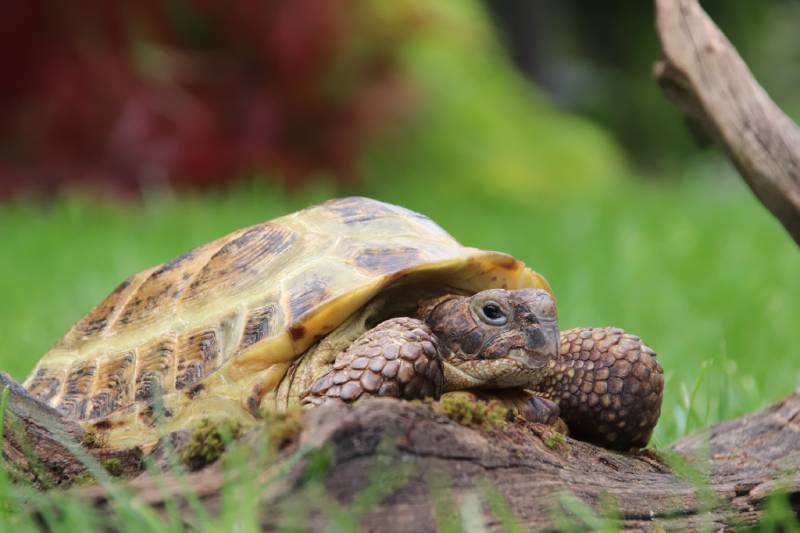
Due to their size and unique personalities, the Russian Tortoise is the most popular tortoise species in North America. That said, the price can range from $100 up to $800. How much you pay depends on several factors, such as where you buy your tortoise (breeder or pet shop) and their sex and age.
If you opt to look for your tortoise in a pet store, ensure that it’s a respectable store with expertise in reptiles. Otherwise, while it might be more expensive, breeders are ideal because you can receive a healthy and well-adjusted tortoise from someone experienced with the species.
Regardless of where you find your tortoise, always research the pet store or breeder, and ensure that you know how to take proper care of a Russian Tortoise.
Russian Tortoise Behavior
Tortoises aren’t known to be overly active pets, which is partly why the Russian Tortoise is so popular. They spend their time exploring their habitat through digging and climbing and can even recognize their owners.
Do These Tortoises Make Good Pets?
Russian Tortoises are also popular because they are fun to watch and easy to look after—as long as you know what you’re doing. These tortoises are okay with being handled when it’s done carefully, as they are social and curious.
These hardy little tortoises can live quite well both indoors and outdoors (weather dependent, of course) and have a long lifespan of over 40 years!
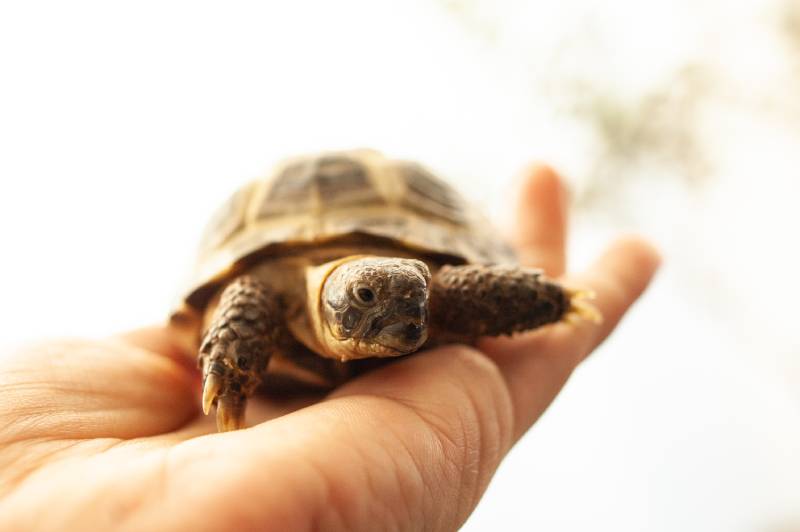
Russian Tortoise Tank Mates
Unless you plan on breeding your Russian Tortoise, it’s usually best to not house them with another tortoise. Placing two male tortoises in the same tank will lead to aggression between them, and two females will likely turn one into a dominant female that will bully the subordinate.
Putting a male and female together will lead to mating, and the male can become more aggressive and start harassing the female as a breeding time approaches. Most breeders only put male and female Russian Tortoises together for brief periods and just for breeding purposes.
If you still plan on keeping more than one tortoise, the tank must be large enough to accommodate each tortoise. There should be plenty of décor and hiding places so they have places to go that are free from stress and harassment.

Care Sheet & Habitat Setup
Light Requirements
In general, tortoises need exposure to UVB lighting. The bulb should be on for about 12 hours every day and turned off overnight so it mimics the natural 24-hour circadian rhythm.
UVB bulbs should be roughly 18 to 20 inches away from your tortoise, and the bulb will need to be replaced every 6 to 12 months.
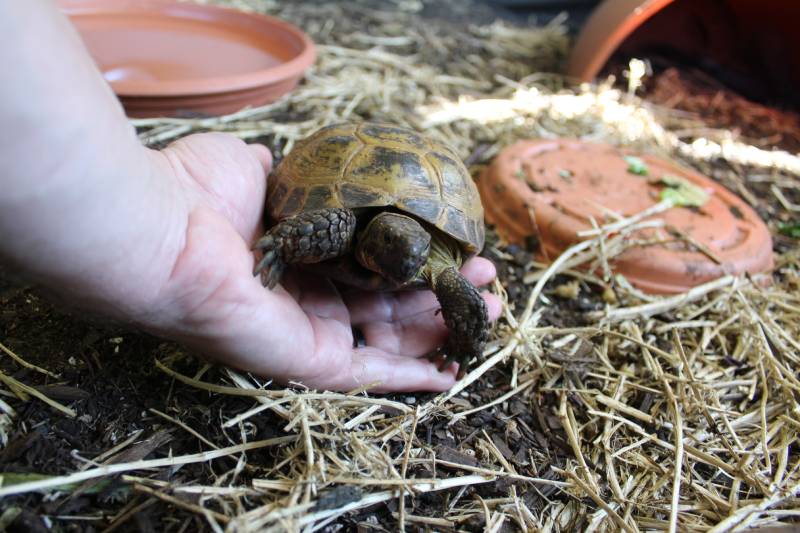
Temperature
The temperature should be maintained between 70°F and 80°F (21°C and 26.6°C). There must be a basking area, which should be about 95°F (35°C), and a cool side in the enclosure, with a temperature at a consistent 70°F (21°C). You’ll need to invest in a thermometer to ensure that your tortoise is comfortable.
Tank Size
If you live in a hot and dry climate, you can keep your tortoise outside. An outdoor enclosure should be roughly 4 x 4 feet for one adult tortoise, and an indoor enclosure should be a minimum of 5 x 5 feet.
The tank can be wood, glass, or plastic, but you’ll want to keep it at least 1 foot deep, as Russian Tortoises can be adept at escaping.
The more tortoises you want in the same tank, the larger it must be. The primary goal is to give them enough room to forage and explore, and they also need adequate air circulation.
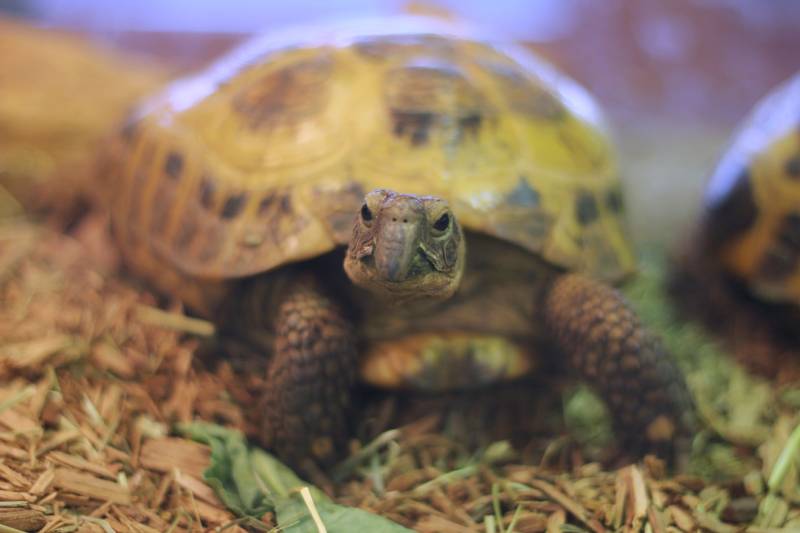
Plants
You should definitely include plants in your tortoise’s enclosure, whether inside or outside. You can add edible plants and herbs (research what is safe for your tortoise), which will add interest and variety.
You should also place rocks and logs for your tortoise to climb under or on. Just be careful not to have a climbing surface that will enable your tortoise to climb out of their enclosure.
Substrate
There is a bit of flexibility with respect to the kind of substrate that you can use with a Russian Tortoise. Mixing a few substrates might work best. Many tortoise owners prefer mixing sand and garden soil with peat moss or coconut coir (coconut fiber).
Since the Russian Tortoise needs a certain amount of humidity, it’s best to avoid substrate that can become moldy. The substrate should be at least 10 inches or more deep so your Russian Tortoise can burrow.
You can also add a few large, flat rocks where you can place food and that will naturally file down your tortoise’s nails.

Things to Know When Owning a Russian Tortoise
Food & Diet Requirements
Russian Tortoises are herbivorous grazers and tend to enjoy eating broadleaf weeds. When kept outdoors, they will eat grass, weeds, and flowers.
Indoor tortoises will need a high-fiber diet that should include dandelion greens, mustard greens, turnip greens, and kale. You’ll need to add calcium supplements to their food two times a week or so, which can be sprinkled directly on their food.
You can also add veggies to their diet, such as sweet potatoes, carrots, peppers, and squash. Feed them in the early morning, and avoid giving them fruit, since it’s not a natural addition to the tortoise diet and might cause diarrhea. Treats for your tortoise can be roses, hostas, hibiscus, and mulberry leaves on occasion.
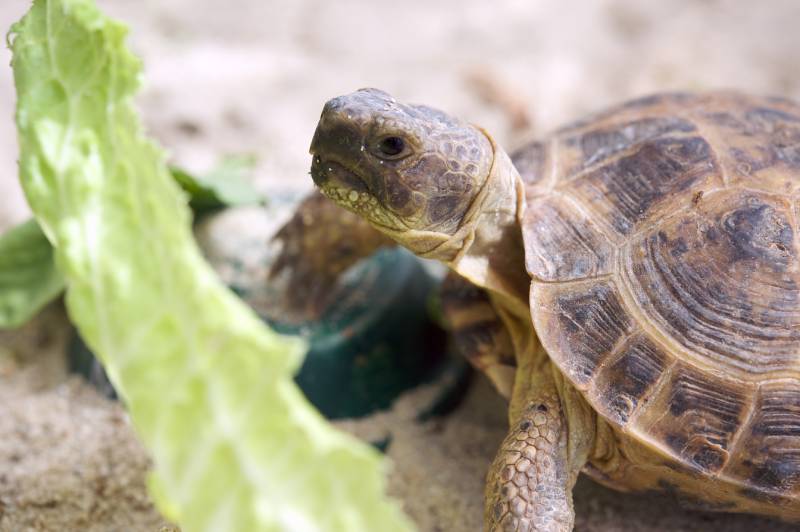
Size & Growth Chart
When a Russian Tortoise lays eggs, it’s usually a clutch of five eggs, which hatch after about 60 to 75 days. The hatchlings start off small at about 1 inch and can grow to 4 ½ inches when they reach sexual maturity by 15 to 20 months of age.
The Russian Tortoise won’t reach their full adult size until they are about 20 to 30 years old, and they can be 6 to 10 inches long.
| Hatchlings | 1 inch |
| Sexually mature (15–20 months) | 4 ½ inches |
| Adult (20–30 years) | 6–10 inches |
Lifespan and Health Conditions
Russian Tortoises are hardy pets with long lifespans that can live through a big chunk of your life. They average 40 to 50 years of age and beyond if you care for them well. But all tortoises are prone to health conditions, the most common being parasites and respiratory problems. Parasites are more likely if your Russian Tortoise was wild caught.
When choosing your tortoise, look for an active and alert tortoise with clean, bright eyes, and only purchase from a reputable source.
Signs of a sick tortoise can include:
Serious Conditions
Male vs. Female
Physically, female Russian Tortoises are larger than males; females are likely to grow 6 to 10 inches and males 5 to 8 inches. But the male’s claws tend to be longer and broader, and they have longer and thinner tails.
Males have a more curved plastron, which is the underside of the shell. This makes it easier for them to mount the females. Male tortoises also tend to have a longer and pointier snout, and the cloaca on the male is found between the middle and end of their tail. The female’s cloaca is near the base of the tail.
Finally, male Russian Tortoises can be more territorial than females, but females can also show territorial aggression.

3 Little-Known Facts About the Russian Tortoise
1. Russian Tortoises can hibernate for as long as 9 months
Russian Tortoises in the wild will hibernate for as long as 9 months (though usually from October to March) and reappear to eat and breed. Some Russian Tortoises kept as pets might hibernate for only 3 to 12 weeks (or not at all), but if their living conditions are inadequate, they can enter hibernation at any time.
2. Two Russian Tortoises were the first to fly around the moon
It’s true! Two Russian Tortoises spent 12 days inside a spacecraft—the Zond 5—in 1968. They were the first living things to circle the moon, and they came back in good overall health.
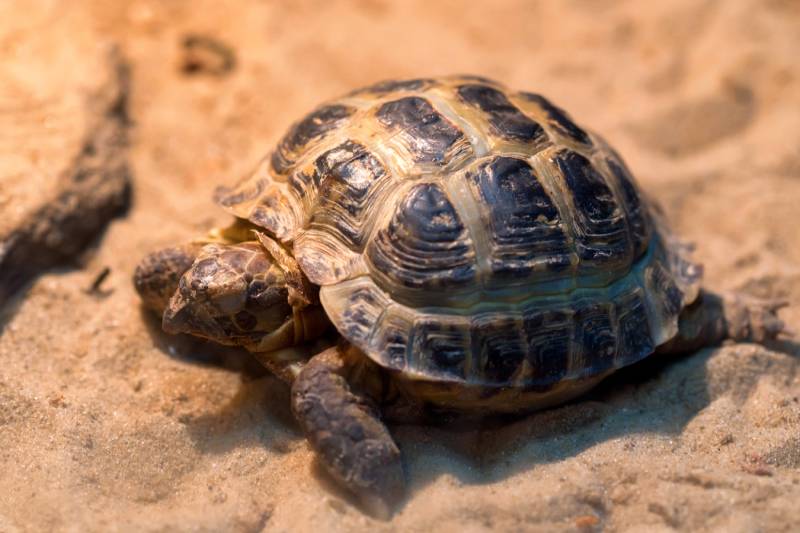
3. The Russian Tortoise is considered a vulnerable species
The International Union for Conservation of Nature has placed the Russian Tortoise on its Red List as vulnerable. While they are common pets, the numbers of the Russian Tortoise in the wild have decreased due to the pet industry.

Final Thoughts
The Russian Tortoise is the most common tortoise kept as a pet due to their social nature and the fact that they are easy to care for and fun to watch. They are great for beginners and experts, are small in size, and live for a long time!
That said, if owning a pet for over 40 years is too long a commitment, you should check out other tortoises, such as the Pancake Tortoise, which is also small and curious and typically live for 30 years.
Still, if you’re interested in owning a tortoise, you’ll need to be in it for the long haul! With the Russian Tortoise, it will be a fantastic ride.
Featured Image Credit: Haoss, Shutterstock
